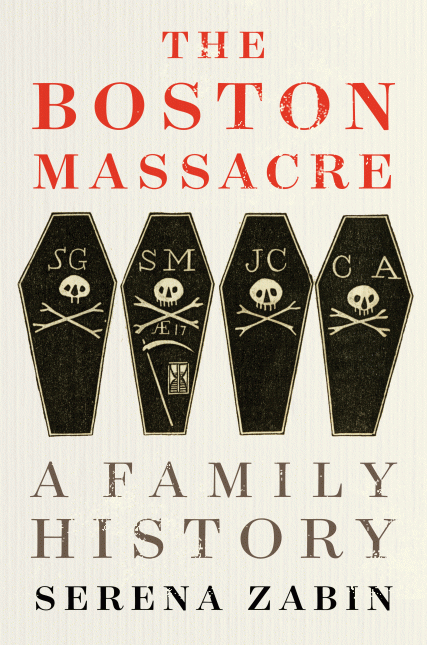The Boston Massacre: A Family History
- By Serena Zabin
- Houghton Mifflin Harcourt
- 288 pp.
- Reviewed by Dean Jobb
- February 6, 2020
By mining archival records, the author brings the human side of the long-ago tragedy to life.

It was supposed to be a simple peacekeeping mission, but even the British commander who dispatched redcoats to Boston in 1768 was apprehensive. The show of force — a bid by the imperial government to quell protests over new import duties levied on the American Colonies — was “a service of a delicate nature,” noted General Thomas Gage, “and possibly leading to consequences not easily foreseen.”
His fears proved well-founded. Within two years, on the night of March 5, 1770, a small detachment of the Twenty-Ninth Regiment was called out to disperse an unruly crowd that had gathered in one of the city’s main squares. When some in the crowd goaded the soldiers to attack and pelted them with snowballs and stones, there was a crackle of musket fire. Eleven civilians were mowed down; three died at the scene and two more later succumbed to their wounds.
To the British, it was an act of self defense, the unfortunate “Incident on King Street.” To Bostonians, it was cold-blooded murder. The future Revolutionary War icon Paul Revere quickly produced an engraving that depicted a line of soldiers callously firing into the crowd, under the bold heading, “THE BLOODY MASSACRE.”
The Boston Massacre was a turning point in the march toward the War of Independence. Britain’s military might and colonists’ demands for liberty collided on Boston’s streets, with deadly results. In The Boston Massacre: A Family History, historian Serena Zabin takes a fresh look at this historic milestone by shifting the focus to the human story that lies beneath this tragic and momentous incident, a “forgotten world…hidden in plain sight.”
Zabin, director of the American studies program at Minnesota’s Carleton College, scoured British army records and Boston archives to peel back layers of mythology and propaganda in search of people caught up in this prelude to the Revolution.
The soldiers sent to garrison Boston “were not bloodthirsty devils stuffed into red coats,” she discovered, but “a mix of hopeful bachelors, family men, scoundrels” that included an aspiring playwright. And not all Bostonians “were steadfast opponents of British power…sorted into tidy factions of loyalist and patriot.” There was no sharp distinction between Us and Them. At least, not yet.
The sudden arrival of more than a thousand soldiers from postings in Ireland and Nova Scotia, many of them accompanied by wives and children, had a profound impact on life in a city of 16,000 people crammed into a single square mile. Soldiers camped on the Common, commandeered meeting halls, and were billeted in homes and outbuildings.
No one could avoid them for long. Military wives befriended their new neighbors. As many as 40 Boston women married soldiers between 1768 and 1772. Local men offered them jobs and helped some of them desert. British officers socialized with prominent citizens, including leaders of the nascent movement for independence.
There was friction, as well, as politics and familiarity bred contempt. Threats and insults were traded. Residents bristled at the indignity of having sentries challenge them as they went about their business. Scuffles broke out in the streets and taverns.
This is big-picture history told on a human scale. Generals, politicians, and other key players get their say, but Zabin is more interested in the lives of ordinary people, especially women. With the help of research assistants, she mined archival records to trace in remarkable detail the experiences of military wives such as Jane Chambers, who accompanied her husband from Ireland and likely endured the death of her child during an outbreak of smallpox in Boston during the summer of 1769.
A Boston woman, Susannah Sloper, was destitute and had given birth to a child in the poorhouse by the time she was 21; her future brightened when she married Private John Brand of the Fourteenth Regiment. Elizabeth Thomas was not so fortunate: She was convicted and fined for the crime of fornication after another British soldier, John Wooll, abandoned her and their illegitimate daughter.
The Boston Massacre presents stories of kindness and cruelty, celebration and loss, suffering and joy, and enriches our understanding of those whose lives would be shattered when the Revolution severed friendships and divided families.
The soldiers who fired on the crowd that fateful night stood trial. Boston juries acquitted the men and their commanding officer, Captain Thomas Preston, of murder; two privates were convicted of manslaughter, but their only punishment was to be branded on the thumb.
Despite the favorable verdicts, General Gage, the commander of British forces in North America, took a dim view of the colonists he was expected to police. Bostonians, he grumbled in the wake of the trials, were “the most Vile sett of Beings in the whole Creation.”
Five years of escalating tensions would pass before war broke out between redcoats and patriots, but the battle lines had been drawn. The personal ties forged during the military occupation of Boston could not withstand the irresistible forces tearing America and Britain apart.
“We think of the American Revolution as a political event,” Zabin notes, “but it was much more like a bad divorce.” And the Anglo-American family that had existed before the Boston Massacre became a monumentally dysfunctional one.
Dean Jobb is the author of Empire of Deception, the true story of a master swindler who scammed the elite of 1920s Chicago (Algonquin Books). He teaches in the MFA in Creative Nonfiction program at the University of King’s College in Halifax, Nova Scotia. Follow him on Twitter at @DeanJobb.

